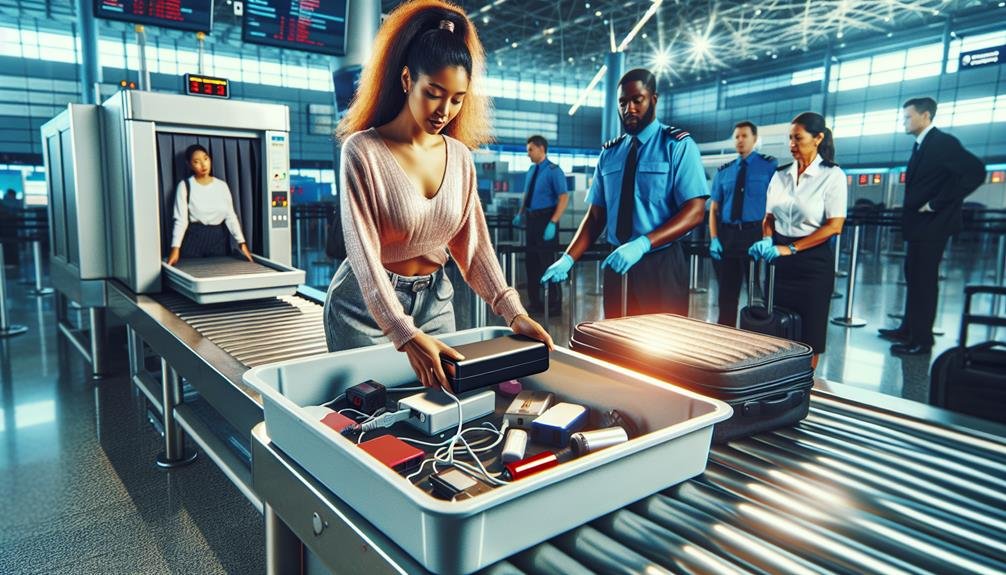You can bring power banks on planes as long as they meet specific regulations. Power banks up to 100 watt-hours (Wh) are generally allowed in carry-on luggage without airline approval. For those between 100Wh and 160Wh, you'll need airline consent. Power banks over 160Wh are usually prohibited. The TSA requires power banks in carry-on, not checked baggage, and the capacity should be clearly marked. Always check with your airline for any additional restrictions to avoid confiscation or delays. Properly packing and labeling your power banks guarantees a hassle-free experience. For more details, explore the nuanced differences in airline policies.
Airline Regulations

When bringing power banks on planes, understanding and complying with specific airline regulations is vital to ensure both safety and adherence to legal requirements. Each airline may have unique rules, but there are common guidelines you should be aware of, especially concerning battery capacity and restrictions.
Firstly, most airlines restrict power banks with a battery capacity exceeding 100 watt-hours (Wh). If your power bank's capacity falls between 100Wh and 160Wh, you'll need to obtain airline approval before flying. Power banks over 160Wh are typically prohibited. Always check the manufacturer's specifications to know your power bank's capacity, as this is crucial for compliance.
International travel adds another layer of complexity. Different countries have varying regulations, so reviewing the rules for each leg of your journey is necessary. Some nations may enforce stricter controls or have additional restrictions on the types of batteries allowed. When planning international travel, consider these variations to avoid any issues at airport security checkpoints or during your flight.
TSA Guidelines
Understanding airline regulations is just one aspect; you also need to be aware of the Transportation Security Administration (TSA) guidelines to guarantee your power bank can be brought through security checkpoints without any issues. The TSA has specific rules to make certain that power banks are transported safely, minimizing fire hazards and other risks.
First, power banks must be carried in your carry-on luggage; they are not allowed in checked baggage due to the potential fire risk from lithium-ion batteries. The TSA scrutinizes power bank capacity closely. Generally, power banks with a capacity of up to 100 watt-hours (Wh) are permitted. If your power bank's capacity falls between 100 to 160 Wh, you'll need airline approval before bringing it on board.
Adhering to TSA guidelines also means being prepared for inspections. It is crucial that the power bank's capacity is clearly marked on the device; this helps TSA officers verify compliance quickly. Don't forget that different airlines might have additional restrictions, so it's vital to check both TSA and airline-specific guidelines.
Battery Capacity Limits
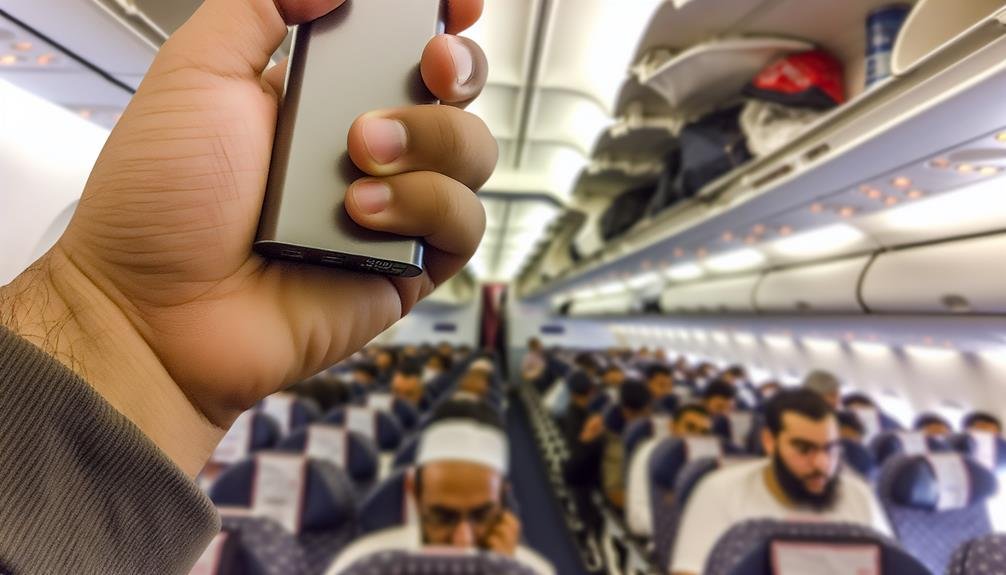
When considering battery capacity limits, you'll need to account for variations in airline policies, calculate watt-hours accurately, and guarantee compliance with safety regulations. Different airlines may have unique restrictions, so it's vital to verify specific guidelines. Additionally, understanding the watt-hour rating of your power bank helps in determining if it meets the required standards for air travel.
Airline Policy Variations
Different airlines impose varying restrictions on the capacity of power banks that passengers can carry on board, often aligning with international safety regulations. While these rules are generally based on guidelines set by bodies like the International Civil Aviation Organization (ICAO) and the International Air Transport Association (IATA), the specifics can differ from one airline to another. Understanding these power bank restrictions is important for guaranteeing a smooth travel experience without compromising safety.
For instance, many airlines allow power banks up to 100 watt-hours (Wh) without prior approval, though some might permit devices between 100 and 160 Wh with special permission. However, others might have stricter limitations or additional requirements, reflecting airline differences in safety protocols and risk management practices.
It's vital to check the specific policies of the airline you're flying with, as failure to comply can result in confiscation of your power bank or denied boarding. By being aware of these variations and prepared to meet the necessary criteria, you can mitigate risks associated with carrying high-capacity batteries. Always prioritize safety and regulatory compliance to guarantee a hassle-free journey.
Watt-Hour Calculations
To secure compliance with airline regulations, it's vital to accurately calculate the watt-hour (Wh) rating of your power bank. Airlines impose watt hour limitations to guarantee safety during flights, and exceeding these limits can result in confiscation or denied boarding. Typically, power banks under 100Wh are allowed without restrictions, but those between 100Wh and 160Wh may require airline approval. Power banks over 160Wh are generally prohibited.
Here's how you can compute the watt-hour rating:
- Wh Formula: Multiply volts (V) by ampere-hours (Ah). For instance, a power bank with 3.7V and 10,000mAh (10Ah) has a Wh rating of 37Wh.
- Label Check: Many power banks list the Wh rating on the label, simplifying the process.
- Conversion: If only milliampere-hours (mAh) are listed, convert to ampere-hours (Ah) by dividing by 1,000 before using the formula.
This calculation is essential for international travel restrictions, as different countries may have varying enforcement levels. Ensuring your power bank adheres to these watt hour limitations will help you avoid potential fines or travel disruptions. Always refer to your airline's specific guidelines to stay informed and travel safely with your power bank.
Safety Regulations Compliance
Make certain your power bank complies with airline safety regulations regarding battery capacity limits to avoid any disruptions during your travel. Airlines and regulatory bodies like the International Air Transport Association (IATA) set specific guidelines to guarantee the safe transport of lithium batteries, which are commonly used in power banks.
First, understand that most airlines impose a battery capacity limit of 100 watt-hours (Wh) for lithium batteries without requiring special approval. For batteries between 100Wh and 160Wh, you may need airline approval. Power banks exceeding 160Wh are generally prohibited. Always check the power bank's label for its watt-hour rating, or calculate it using the formula: Wh = (mAh/1000) x Voltage.
Voltage restrictions also play a pivotal role. The typical voltage for lithium-ion cells is 3.7V, but always verify this to ensure compliance. Higher voltages can pose a greater risk of overheating or explosion, hence the stringent rules.
Lastly, be aware of airline-specific regulations, as they can vary. Some airlines may have stricter rules or additional requirements. Being proactive about compliance will help you avoid confiscation of your power bank and ensure a smooth travel experience.
Carry-On Vs. Checked Luggage
When you're flying, it's important to know that TSA regulations require power banks to be carried in your carry-on luggage, not checked baggage. Different airlines may have specific policies about the watt-hour limits and quantity of power banks you can bring. For safety, make sure your power banks are properly insulated and stored to prevent short circuits or overheating during transit.
TSA Regulations for Power Banks
As per TSA regulations, you're required to carry power banks in your carry-on luggage rather than checked baggage to mitigate potential fire risks. This rule is important for guaranteeing in-flight safety and maintaining control over any overheating incidents. Power banks in checked luggage pose a significant hazard due to the lack of real-time monitoring.
When it comes to charging restrictions and airline restrictions, you need to be aware of various rules:
- Follow the airline's specific guidelines for the maximum allowable battery capacity.
- Make sure each power bank has its capacity clearly labeled to avoid complications during security checks.
- Remember that international travel restrictions may differ, so always check the regulations of the country you're flying to.
The TSA also imposes specific limits on the watt-hour (Wh) rating of power banks. Typically, power banks must be under 100Wh to be unrestricted. For power banks between 100Wh and 160Wh, you'll need airline approval. Power banks over 160Wh are generally prohibited.
For your safety, always pack power banks in your carry-on where cabin crew can promptly address any issues. Adhering to these guidelines not only guarantees compliance but also promotes a safer flying experience for everyone onboard.
Airline-Specific Power Bank Policies
Different airlines have their own specific policies regarding whether power banks should be carried in your carry-on luggage or if there are exceptions for checked luggage. Generally, most airlines require you to carry power banks in your carry-on due to the risk of thermal runaway and potential fires. However, power bank sizes and their watt-hour (Wh) ratings greatly influence these policies.
For instance, many airlines restrict power banks with a capacity of over 100Wh unless you receive prior approval. Some airlines allow power banks between 100Wh and 160Wh but often limit you to carrying only two such devices. Always check the airline's guidelines because exceeding the allowed power bank sizes can result in confiscation or denied boarding.
Charging restrictions also play a role. Airlines typically prohibit using power banks to charge devices during certain phases of the flight, like takeoff and landing, to guarantee safety. You should familiarize yourself with these policies to avoid complications.
Safety Tips for Transport
To ensure the safe transport of power banks, always carry them in your carry-on luggage rather than checked baggage. This practice aligns with travel regulations and guarantees battery safety during your journey. Power banks, which are vital travel essentials, can pose risks if mishandled. Carrying them in your carry-on provides easy access and allows crew to respond swiftly in case of any issues.
To enhance safety and compliance with travel regulations, consider the following tips:
- Check Capacity Limits: Verify the watt-hour rating of your power bank. Most airlines allow power banks up to 100Wh without special approval. For those between 100Wh and 160Wh, you might need airline approval.
- Use Protective Cases: Store power banks in cases to prevent short-circuits. Make sure they don't come in contact with metal objects like keys or coins.
- Monitor Charging Options: Avoid charging your power bank during the flight unless absolutely necessary. If you must, utilize airline-approved charging options.
Adhering to these guidelines not only guarantees battery safety but also enhances the overall safety of all passengers on board. Always prioritize these practices to mitigate risks and enjoy a hassle-free travel experience.
How to Pack Safely
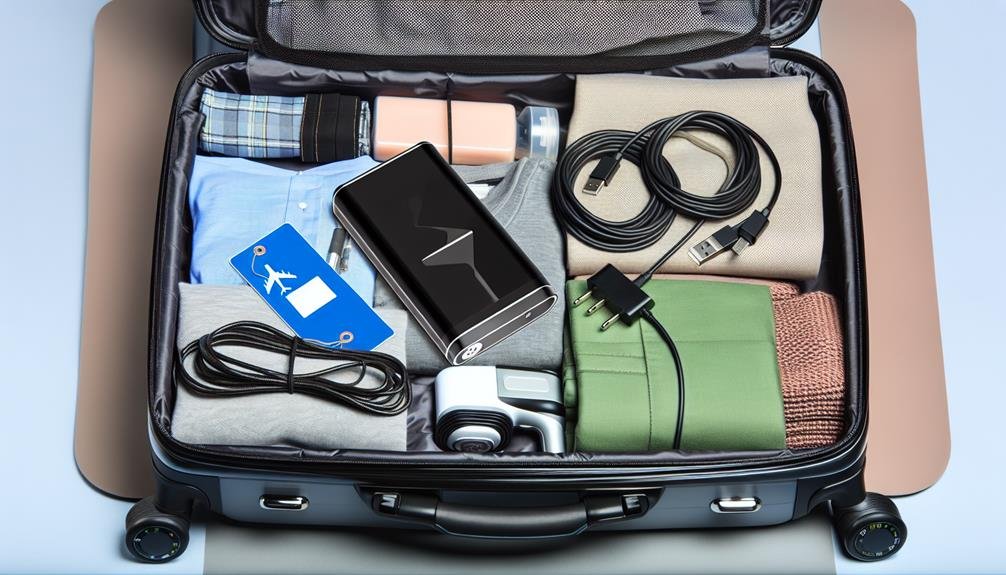
When packing power banks for air travel, make sure they're stored in your carry-on luggage to comply with airline safety regulations. This is an important step in ensuring both your safety and the safety of other passengers. Airlines typically prohibit power banks in checked luggage due to the risk of overheating and fire.
For best safety, use these packing tips: Keep your power banks in a protective case to prevent any physical damage during transit. Make sure that the power bank's capacity (mAh) is clearly labeled, as airlines may need to verify it. Avoid packing power banks with metal objects that could cause a short circuit.
As part of your travel essentials, consider power banks that come with multiple charging options. These can be a lifesaver when you're on the go and need to charge various devices. Safety precautions are essential—only use power banks that have passed relevant safety certifications (e.g., UL, CE).
Lastly, always have your power banks easily accessible. Security personnel might need to inspect them, and having them in a convenient spot can expedite the process. Keeping these guidelines in mind will make your air travel smoother and safer.
International Rules
Internationally, airlines often have varying regulations regarding the transport of power banks, so acquainting yourself with the specific rules of the countries you'll be traveling to and from is crucial. These regulations are typically influenced by international safety standards concerning lithium batteries, which are known for their potential fire hazards.
When planning your trip, consider the following critical aspects:
- Power bank capacity limits: Most countries restrict power banks to a maximum of 100 watt-hours (Wh) without prior airline approval. Devices between 100Wh and 160Wh usually require airline consent, and those over 160Wh are generally prohibited.
- Quantity restrictions: Many countries limit the number of power banks you can carry. Commonly, you're allowed to bring a maximum of two power banks, but this can vary.
- Carry-on requirements: Power banks must be transported in your carry-on luggage. Carrying them in checked baggage is often prohibited due to the risk of overheating and fire.
Ensuring compliance with these power bank restrictions during international travel helps you avoid delays at airport security and reduces the risk of safety incidents. Always check the latest guidelines from both your departure and destination countries to stay updated on the current rules.
Airline-Specific Policies
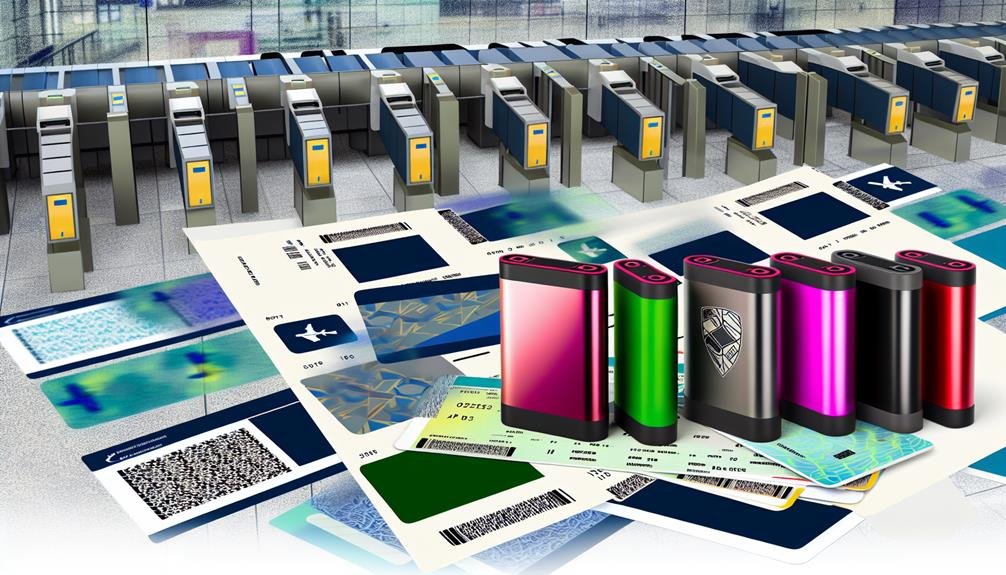
When you're traveling with power banks, it's important to understand that different airlines have specific regulations regarding their transport. Major airlines often have distinct rules about whether power banks can be carried in your hand luggage or must be checked in. Knowing these policies helps you avoid potential safety risks and guarantees compliance with airline regulations.
Major Airlines' Regulations
For those planning to fly, understanding each major airline's specific regulations regarding power banks is important to guarantee compliance and avoid potential travel disruptions. Different airlines have distinct policies, primarily concerning battery capacity and travel safety. Familiarizing yourself with these rules can help secure smooth boarding.
Most major airlines enforce strict guidelines on power banks:
- American Airlines: Allows power banks with a battery capacity of up to 100Wh without prior approval. For devices between 100Wh and 160Wh, you'll need airline consent.
- Delta Airlines: Permits power banks up to 100Wh. Devices exceeding this limit up to 160Wh require permission and are usually limited to two per passenger.
- United Airlines: Similar to other carriers, allows power banks up to 100Wh without restriction. For batteries between 100Wh and 160Wh, you must seek approval and can carry a maximum of two.
These guidelines secure travel safety by minimizing risks associated with lithium-ion batteries. Always double-check the airline's specific regulations before packing your power bank. By adhering to these rules, you can avoid delays and ensure a safer flying experience.
Carry-On Vs. Checked
You need to know each airline's specific policies on whether power banks should be carried in your carry-on luggage or checked baggage. Generally, power banks must be transported in carry-on luggage due to safety precautions. This is because power banks contain lithium-ion batteries, which can pose fire risks if damaged.
Here's a quick reference table for some major airlines:
| Airline | Power Bank Policy |
|---|---|
| Delta Airlines | Carry-on only |
| American Airlines | Carry-on only |
| United Airlines | Carry-on only |
When planning your trip, review your airline's guidelines to guarantee compliance. Power banks in checked baggage are usually prohibited due to the inability to manage potential fire hazards promptly. In contrast, having them in your carry-on allows flight attendants to handle any issues immediately.
Charging options on the plane can also influence your decision. Some airlines offer in-seat power outlets, making it convenient to keep your devices charged without needing to use your power bank during the flight. Always check the battery capacity of your power bank, as most airlines limit it to 100Wh. Acquaint yourself with these rules to avoid any last-minute hassles and ensure a safe journey.
What to Avoid
One crucial thing to avoid is carrying power banks with a capacity exceeding the airline's specified limits. Different airlines enforce varied restrictions on battery capacity, typically measured in watt-hours (Wh). Exceeding these limits can result in you being unable to board with your power bank, causing delays and potential confiscation.
To guarantee compliance and safety, avoid:
- High-capacity power banks: Generally, power banks exceeding 100Wh need special permission. Always check your airline's policy.
- Unmarked batteries: Power banks should clearly display their capacity in mAh or Wh. Unmarked batteries can raise suspicion and lead to confiscation.
- Damaged power banks: Any signs of swelling, leakage, or damage can not only prevent you from flying but also pose significant safety risks.
Airline restrictions are in place to mitigate risks associated with lithium-ion batteries, such as overheating and fire hazards. Make sure to verify the battery capacity of your power bank before packing it. Adhering to these guidelines ensures a smoother and safer travel experience for everyone on board.
Paying close attention to these details helps you navigate airline regulations effectively, keeping your power banks within safe and permissible limits.
Alternative Charging Options
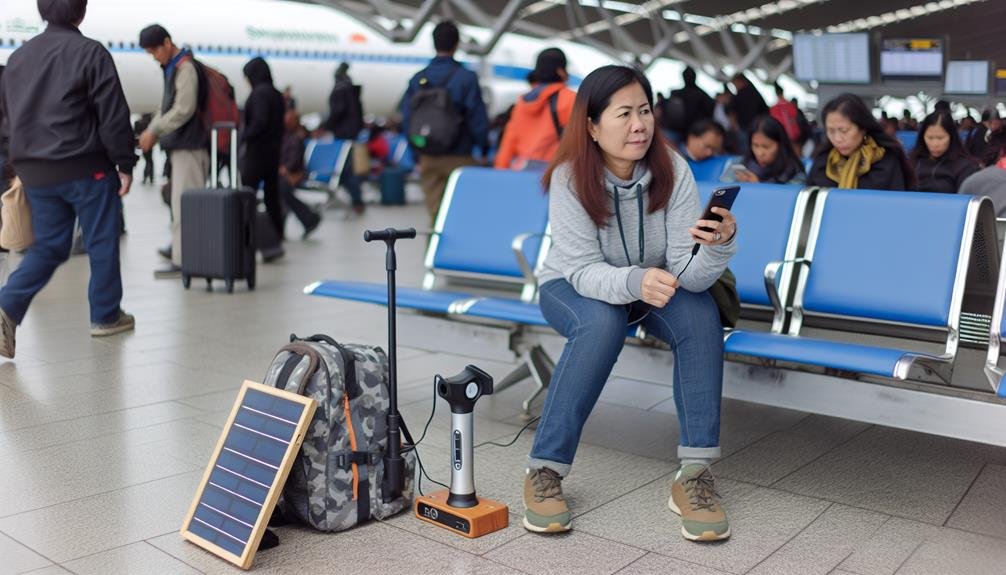
While bringing power banks on planes is common, travelers often need to explore alternative charging options to guarantee compliance with airline regulations. One viable option is solar chargers. These devices harness sunlight to generate power, presenting a risk-free alternative to traditional power banks. Solar chargers are typically lightweight and devoid of significant regulatory restrictions, making them an excellent choice for frequent flyers aiming to maintain device functionality without breaching airline policies.
Another alternative is portable generators. These compact units can deliver substantial power output, allowing you to charge multiple devices simultaneously. However, it's essential to verify your portable generator meets airline regulations concerning battery type and capacity. Lithium-ion batteries, commonly found in portable generators, are subject to stringent airline safety measures. Always check the watt-hour rating and confirm compliance with the carrier's specific guidelines to avoid confiscation or delays.
Both solar chargers and portable generators offer robust, regulatory-compliant solutions to your charging needs. By considering these alternatives, you can mitigate risks associated with carrying power banks while securing that your electronic devices remain operational throughout your journey. Prioritize safety and adherence to regulations to guarantee a smooth travel experience.
Tips for Safe Travel
Securing a safe travel experience hinges on understanding and adhering to specific airline regulations and best practices for managing your electronic devices and power sources. Your packing strategy should prioritize safety and compliance, especially when including power banks in your travel essentials.
First, familiarize yourself with the airline's rules regarding power banks. Most airlines allow power banks in carry-on luggage but not in checked bags due to the risk of fire. Check the watt-hour (Wh) rating of your power bank; typically, those under 100 Wh are permitted without prior approval, while those between 100-160 Wh might require airline consent.
At airport security, be prepared to remove power banks from your carry-on for separate screening. This step guarantees compliance with airport security and customs regulations, preventing delays and potential confiscation.
Here are some key packing tips:
- Use a protective case: Safeguard your power bank from physical damage and short-circuiting.
- Avoid overpacking: Make sure your carry-on isn't overloaded, making it easier to follow security protocols.
- Label your devices: Clearly mark your power banks with their capacity to streamline security checks.
Frequently Asked Questions
Can You Use Power Banks During the Flight?
Yes, you can use power banks during the flight for charging devices. Make sure the battery capacity complies with airline regulations, typically below 100Wh. Always follow crew instructions and keep the power bank in your carry-on.
Are There Any Brands of Power Banks Not Allowed on Planes?
Better safe than sorry! Some restricted brands of power banks are not allowed on planes due to safety concerns. Airline regulations often list these brands, so always check before you pack to guarantee compliance and safety.
How Do You Check the Power Bank's Capacity in Watt-Hours?
To check a power bank's capacity in watt-hours, multiply its voltage (V) by its capacity in amp-hours (Ah). Calculating capacity guarantees compliance with airline regulations, enhancing safety and minimizing travel risks.
Can Multiple Power Banks Be Brought on a Single Flight?
You can bring multiple power banks on a single flight, but airplane regulations limit capacity and quantity. Confirm compliance with safety precautions for power banks by checking airline-specific rules to minimize risks and guarantee safety during travel.
What Should You Do if Your Power Bank Overheats During the Flight?
If your power bank overheats during the flight, like a stove left on too long, follow safety precautions and troubleshooting steps. Immediately inform the crew, adhere to emergency procedures, and comply with airline regulations to guarantee everyone's safety.

